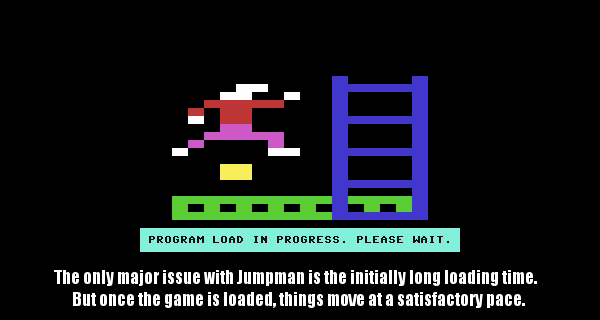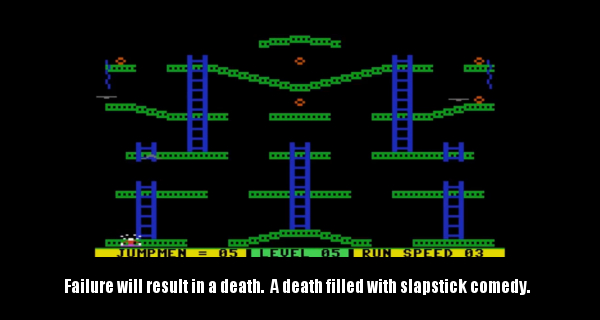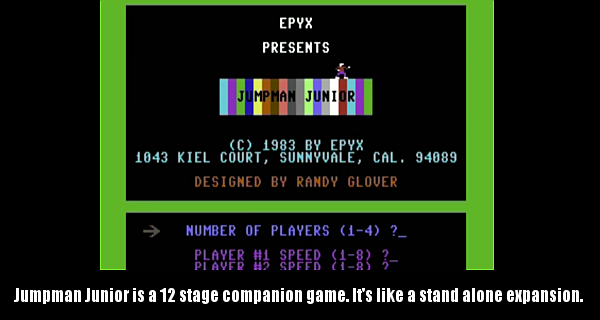
Ever since Atari devised the original Atari Flashback line (Which it handed over to ATGames, who has kept the line going), the craze for replica consoles with built-in games has been going strong. Nintendo set the bar for them even higher with its NES, and Super NES Classic Edition machines. Even before this craze however, there were similar devices. Systems built into a controller from a wide variety of vendors like Jakks Pacific. And there was even the C64 DTV I reviewed a while ago. Well now there’s a new take on this mini console idea. As Retro Games LTD brings us a Commodore 64 iteration.
PROS: Excellent emulation. Feature rich. It’s a baby Commodore 64!
CONS: Game selection should have been better. No AC Adapter.
COMMODORE BASIC: You can actually code in it on this device.
Released throughout Europe earlier this year, the C64 Mini finally made its appearance Stateside, and so I picked one up. I pretty much had to as someone who used a Commodore 64 regularly throughout their childhood, and into their teens. The Commodore 64 was the best-selling home computer platform of all time. Released in 1983, and sold until 1994 when Commodore went out of business. And it was well supported in every major territory for most of that time. The American, and European markets differed in some of the game line ups. In Europe a host of publishers, and developers cut their teeth on it, and became the juggernauts they are today. Many games were exclusive to the European market despite being a machine made by an American company. Here in the USA, Commodore (as well as Atari, IBM, and Apple) scooped up most of the publisher support consoles once had. When the great crash happened, and machines like the Odyssey 2, Colecovision, Intellivision, Atari 5200, Bally Astrocade, and others fell by the wayside it was the home computer platforms surviving companies shifted to. Even after the Nintendo Entertainment System reignited the console market, many games continued to see versions on the microcomputers. In Europe, the home computer platforms were almost always preferred, and so there was never really this kind of shift, leading to a wellspring of exclusive amazing games US owners never saw.
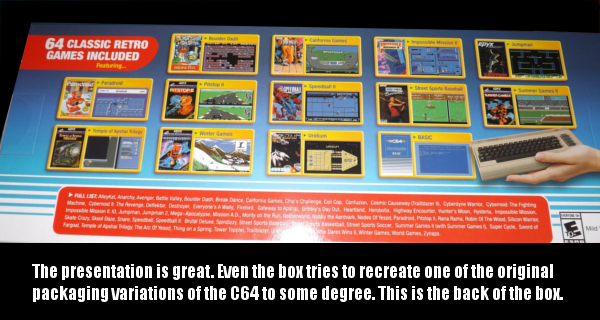
Whichever part of the world you hail from though, the Commodore 64 had a massive following. As such it got a ton of games that not only appeared on consoles from the Atari 2600 to the NES to the Sega Master System, but IBM PC Compatibles as well. That’s besides the stuff that it had exclusively, or only shared with a couple of other computer platforms of the day. It was the platform to own until the NES showed up, and even then it still held its own into the shift toward 16-bit processor powered platforms like the Sega Genesis, Super NES, and Amiga computer line. And nothing has or ever will sound as awesome as a Commodore 64 again. It’s Sound Interface Device (SID) chip featured dynamic sound. Something even some arguably more powerful machines didn’t have. Bob Yannes truly was a master of sound chip design.
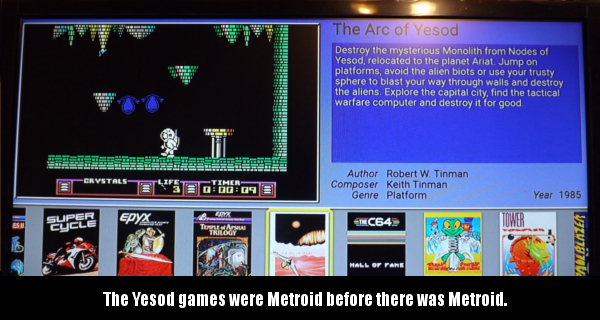
So what makes the C64 mini so special? Well for starters, it’s a miniature replica of a Commodore 64. The designers got every major detail down on this thing. Of course they aren’t the defunct Commodore of old, so instead of COMMODORE being laden along the top, they’ve displayed C64 Mini. Other than that one change, it’s perfect. Mine had a minor tilted paint application by the power button, but one tiny manufacturing error is a very minor nitpick. I have to say that the presentation in this product is top-notch. The packaging is great. Like the Super NES Classic Edition, they’ve tried to re-create one of the C64 box releases, and have done well. On the back they show off the game list, and this is where the one disappointment crops up. But I’ll get to that in a bit.
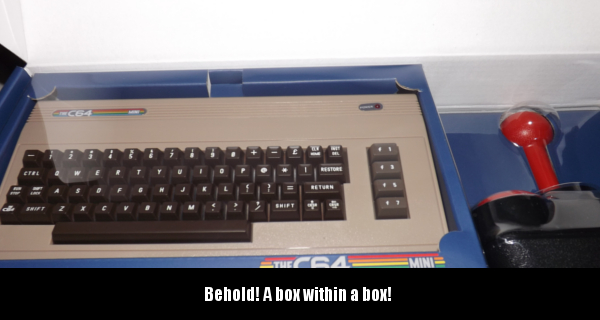
Opening the box reveals another box, one that feels luxurious despite just being more cardboard. It’s embossed with a beautiful logo, and upon opening it, you’ll see both the computer, and classic style joystick replica encased in a removable clamshell. Upon taking those out, you’ll find your cables, and documentation underneath. It should be noted that if you’re the type who likes to re-seal, and pack away your consoles when not in use, the packaging is accommodating. It’s very easy to put back everything where it goes for putting away. In the box you’ll get the C64 Mini, a Joystick, HDMI cable, USB cable for power, and documentation. Unfortunately for whatever reason it does not have an AC adapter. So unless your HDTV has a USB port for you use, you’ll need to buy a USB to AC adapter if you don’t already have one for another device like a smart phone.
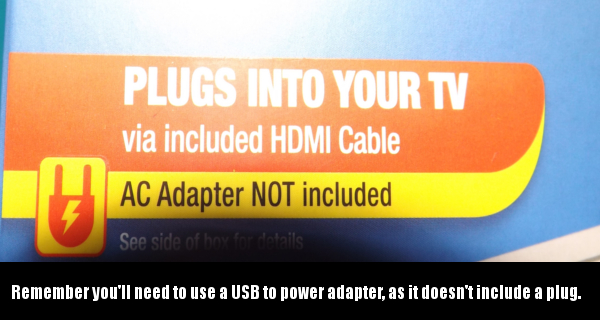
Upon turning on the device you’ll hear a glorious original chip tune, as you’re greeted with a simple language selection screen. Once you choose your language you’ll see a panorama of the devices built-in games. At the bottom are a couple of icons. You’ll have one for display options. These are very much like the ones on the Super NES Classic Edition. You can choose aspect ratio, and select from a few filters. Another icon lets you go back into the language selection, while the third lets you go in, and change other settings. One of which shows you the Firmware version. Here’s the cool thing. If you go to the manufacturer’s site, you can get the latest update for free. Put the update on a flash drive, and you can install it on the C64 Mini. When you do this, the device will reboot, and when it does you’ll see a USB flash drive icon at the bottom of the screen. This lets you read disk images off of a flash drive! So if you have a means to back up your collection to disk images, you have the potential to run them on the C64 Mini! This is also a great option for anybody who buys an indie game for their C64, as often times homebrew developers will have a digital image option or inclusion with their disk or cartridge. This is also great for anybody who enjoys the C64 Demo scene, as again, you can run these audiovisual projects on the C64 Mini!
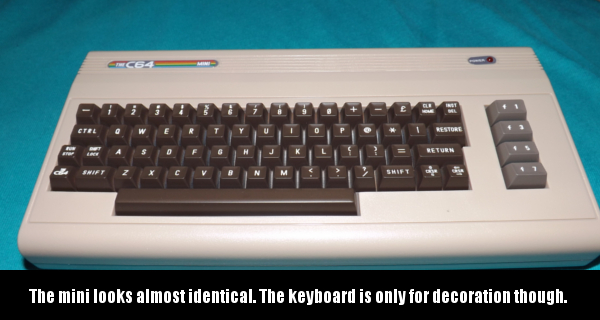
As for the games that are included here, the list of titles is a mixed bag. There are a few very memorable C64 games on here. Especially from the now defunct Epyx. The Apshai series is here, which is an amazing line of early Action RPGs. Jump Man, and Jump Man 2 are here, and while even back upon release they weren’t much to look at, they were amazing. These are two of the best platform-puzzlers ever released. This device also has the two Impossible Mission games which are also two must-plays. Rounding out the Epyx catalog are some of their better known sports games including California Games. These aren’t what one would call system sellers, but they are probably the best versions of these titles.
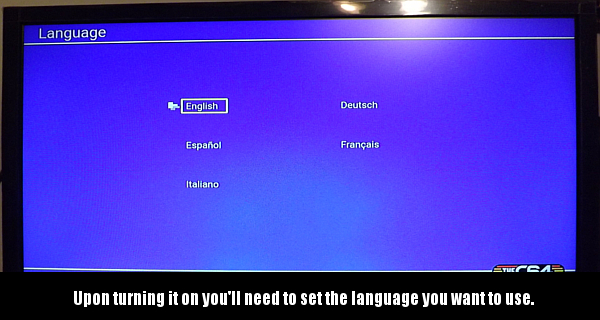
The Mini also has a few Firebird releases on it. Firebird wasn’t as well-known in the States as it was in Europe, but they still did release a lot of their better titles in the US. Two of the better ones here are The Arc Of Yesod, and The Nodes Of Yesod two games that feel like precursors to Metroid. They’re labyrinthine, and action packed games that while admittedly aren’t as good as Metroid, are still really well made. There are also a host of Shmups by Hewson Consultants on here which were always lauded back in the day. Cybernoid, and Cybernoid II are here, and play as great as ever. Cybernoid was an early C64 staple, and one that remains superior to its NES counterpart. Uridium is also here, which NES fans may recognize as The Last Starfighter. (Mindscape re-skinned it, and ported it long after the movie came, and went). They also put the excellent Zynaps on here, as well as Firebird’s IO. So there are some excellent Shoot ’em ups on display.

The other two major titles on the device are Boulder Dash, and Tower Toppler/Nebulus. These games are excellent arcade style games with puzzle elements. I’ve talked about Boulder Dash a few times on the blog here, and truly is one of the best games of its ilk ever made. It’s great to see it here once again. Tower Toppler is a very challenging game that has an awesome pseudo-3D effect at the forefront of its gameplay. It saw release on other platforms, but the Commodore 64 version was always one of the best versions. There is also a really cool Demo on it that doubles as an end credits sequence. It shows off the names of everyone involved in making it, and a lot of creativity in the process.

As for the rest of the games, there aren’t too many I would say to stay away from. But they’re not the most compelling titles either. Save for Monty On The Run, many of them were lower tier releases in Europe, and so many North American players will not know anything about these games. It’s a real shame that the folks at Retro Games LTD couldn’t have found a way to get some of the major releases from Activision, Electronic Arts, Capcom, Konami, SEGA, Lucas Arts, or Data East. Or some of the classic Broderbund, Accolade, Cinemaware, Access Software, System 3, or Microprose releases. Granted few of these publishers are around anymore, and I’m sure there are all kinds of rights hell complications in getting their games to market again. Still, most of their exclusive games were amazing, and the ones that would appear on other platforms, were still excellent on the Commodore 64. (Most of the time. There were some ports that were stinkers.) I would have also liked to see some of the higher profile European releases like Katakis, Phantis, or Turrican II on here, or some of the American gems like Paul Norman‘s games Forbidden Forest, Beyond The Forbidden Forest, Caverns Of Khafka, Aztec Challenge, or Super Huey. Cosmi published them, and are still around today. They don’t publish much in the way of games anymore, but permission may not be out of the realm of possibility.
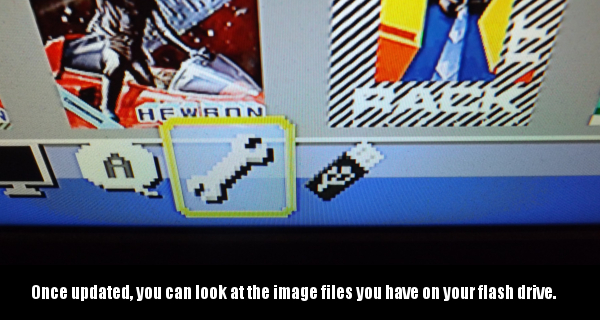
Be that as it may, the fact you can run backup images, and homebrew releases makes up for the lack of more recognizable games in the roster. And although you may not have heard of some of the included ones, most of them are still enjoyable enough. You could very well find you get a lot of mileage out of Who Dares Wins II It may not be the best Run ‘n Gun you’ll ever play, but it is a pretty respectable Commando clone. One really cool inclusion here is the classic Commodore 64 BASIC prompt. Like all of the 8-Bit microcomputers of the time, one had to use BASIC commands to load programs, search media for files or save files. But you could also code in BASIC! So if you’re a budding developer willing to learn the language, you can code your own games, and save them to a flash drive! You can also type in those old programs printed in classic magazines like Ahoy!, or Commodore RUN.

The mini also has a spiffy on-screen keyboard you can pull up using the joystick, although I have to say, a USB keyboard is preferred. Especially when playing classic RPGs, coding in BASIC, or playing text adventures. The included joystick is a really well made one. It’s tactile, re-centers itself nicely, and the fire buttons have a nice mechanical spring design. The joystick also has a hotkey on it for pulling up menus, and the on-screen keyboard, as well as the Space bar button, and Return button. This makes navigating action games much easier, as you don’t have to frantically look for a key on your keyboard. However the drawback to this is that if for any reason you break the joystick, navigating things may become a bit iffy. So treat the joystick like fine china. Fortunately you can acquire spare joysticks separately. However, not all of the big box stores who carry the mini, carry the standalone joysticks. I also forgot to mention the C64 mini also supports save states. So you’ll be able to save scum your way through some of the more difficult sections of games, or just simply create a save point in general. Not every Commodore 64 game had a save feature, so being able to create a save file for some of the longer games available for the computer is very convenient.
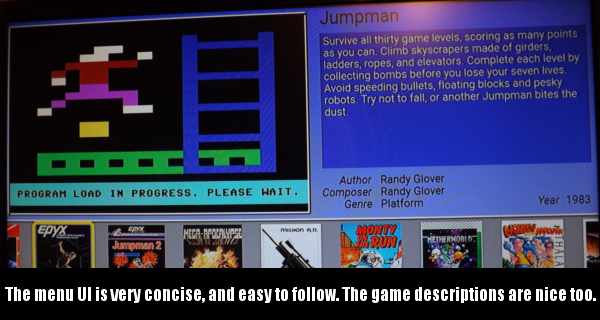
Emulation on the C64 mini is very good. Visually everything looks the way it is supposed to. The color palette is on par with the original computer’s. Graphics look crisp, and the sprites all look as good as they would on the original hardware. The different filters, and aspect ratios all work very well too. So if you don’t like the computer monitor look of the different settings you can put on one of the CRT filters I briefly mentioned earlier. Personally I recommend the pixel perfect or 4:3 aspect ratio, as they look cleaner. But if you prefer the look of scan lines, the filters do a pretty good job here.
Sound emulation is also spot on. Of course depending on the model of the original computer there were two major sound chip versions, with revisions of each throughout the production run. The mini appears to sound more like the earlier versions of the chip, which makes sense since the casing is modeled after the earlier version of the computer, and not the C64c re-release. The C64c had the later chip versions, and so there are some slight sound differences between the earlier C64’s, and the C64c (A C64 in a new casing). In any case, the sound veers toward the original model here.

As far as the performance goes, it too is very good. Things run at a great pace, and I have yet to experience slowdown the original computer wouldn’t. I also haven’t noticed any considerable amount of input lag when playing games on it. I’ve tried it on three TV sets, a 720p 32″ Element LCD, an Insignia (Best Buy) 720p 19″ LCD, and a Samsung 4K 42″ LCD. I only ever noticed it on the Samsung, and even then, just barely. For the overwhelming majority of people who pick this up, it’s going to be a great experience.

In closing, the C64 mini is one of the best of these miniature emulation devices to see release in recent years. While Nintendo’s releases have more recognizable games in their line ups, this device has better functionality. The ability to use virtually any USB controllers or keyboards paired with some of the best emulation around makes for an almost 1:1 experience. Plus, the inclusion of the classic BASIC prompt means you can make your own programs. This even adds an educational level to the package. Not only do you get a piece of video game history, but you can learn about, and learn how to code in a programming language. True it isn’t as robust as a modern language, but it still gives you the building blocks, and helps you better understand where modern technology came from. I wouldn’t be surprised to find school teachers or other instructors picking this up for that purpose.
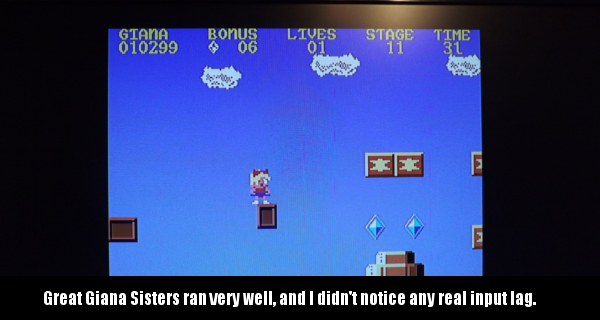
Really, the only drawback is that it could have used a few more higher profile games in the line up. I would recommend getting a spare joystick for it at some point as well, just on the off-chance you somehow break the included one. The odds aren’t very high (again, the build quality is actually quite good.) but it’s just one of those just in case things you should have. Still, while it isn’t as cool as an actual Commodore 64 (though short of a FPGA powered clone compatible with the original’s drives, and software, what can be?) but it’s close. Real close. Its shortcomings are more than made up for by its features. This is simply the best mini platform not made by Nintendo. If you’re a long time Commodore 64 fan or collector, you’ll love that it makes C64 HDTV gaming a snap. If you’ve never experienced a C64, and want to without having to invest a few hundred dollars into obtaining one, its peripherals, and games this is a great option. It’s also a great device for anyone who wants to learn about early computers, and the use of BASIC programming as an Operating System. Even if none of those things apply to you, the wealth of indie homebrew games being made for the original C64 may just pique your interest. Again, the digital images for many of them can be run via flash drive.
Final Score: 9 out of 10

